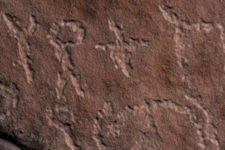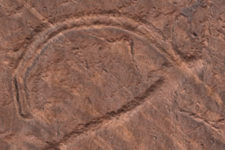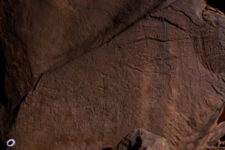Click the lightbulb icon and drag your cursor to move the light source around the RTI.
RTIs are compilations of a series of photographic images of a given object taken with varying lighting direction. They consist of a series of images of the same subject produced in a computer file format that permits lighting direction to be controlled interactively online. There are several advantages to RTI imaging. Primarily, it increases the visibility of subtle morphological details on the surfaces of objects and enhances photorealism. Because we found that others had used Reflectance Transformation Imaging successfully to examine writing on clay tablets and designs on Mongolian deerstone stela, we thought it could be equally effective in the study of petroglyphs. Our results substantiate this, and we hope to return and do even more RTIs in Saudi Arabia in the near future.
The most practical method for creating RTIs of petroglyphs, or any other subject photographed in the field, uses a technique referred to as Highlight Based RTI. First, a perfectly round, shiny black ball is placed next to the subject being photographed. Next, multiple photos of the subject and ball are shot with a digital camera set on a tripod, triggered by a handheld flash. Each time a new photo is shot, the flash unit is moved to a new position about a virtual hemisphere, always keeping it at a uniform distance from the object. Allowing the flash to trigger the camera, multiple images are thus taken with different lighting directions. All the image files are then placed into a directory on the computer, and that directory is chosen within the Highlight PTM* Builder application. The Highlight PTM Builder tool automatically finds the ball in the images, registers the light direction reflected on the ball, and constructs a RTI from this dataset.
* Polynomial Texture Map, another name for RTI.



